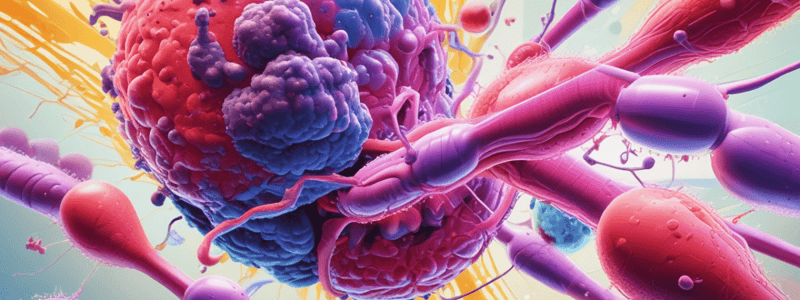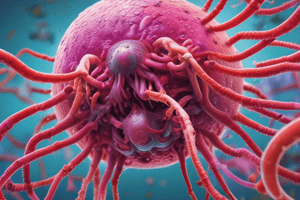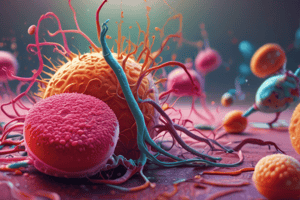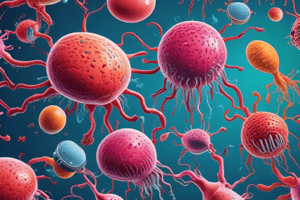Podcast
Questions and Answers
Which pathogen is known for causing cholera?
Which pathogen is known for causing cholera?
- Giardia intestinalis
- Vibrio cholerae O1 (correct)
- Rotavirus
- Bison
What type of toxin is associated with cholera?
What type of toxin is associated with cholera?
- Enterotoxin
- Neurotoxin
- Endotoxin
- Exotoxin (correct)
Which virus is resistant to Chlorine?
Which virus is resistant to Chlorine?
- Norovirus
- Hepatitis A virus (correct)
- Rotavirus
- Poliovirus
Which disease is caused by abnormal folded proteins called Prions?
Which disease is caused by abnormal folded proteins called Prions?
What is the mode of transmission of Poliovirus?
What is the mode of transmission of Poliovirus?
Which parasite is known to cause prolonged diarrhea?
Which parasite is known to cause prolonged diarrhea?
What is the primary source of infection for Beef Tapeworm?
What is the primary source of infection for Beef Tapeworm?
'Ophthalmic cysticercosis' refers to larvae lodged in which organ?
'Ophthalmic cysticercosis' refers to larvae lodged in which organ?
'Neurocysticercosis' refers to larvae developing in which part of the body?
'Neurocysticercosis' refers to larvae developing in which part of the body?
Which bacterium is responsible for Staphylococcal Food Intoxication?
Which bacterium is responsible for Staphylococcal Food Intoxication?
What symptom is associated with Clostridium botulinum infection?
What symptom is associated with Clostridium botulinum infection?
Which bacterium causes Typhoid Fever?
Which bacterium causes Typhoid Fever?
What is the characteristic symptom of Hemorrhagic Colitis?
What is the characteristic symptom of Hemorrhagic Colitis?
Which bacterium is associated with Bacterial Gastroenteritis, also known as Traveler's diarrhea?
Which bacterium is associated with Bacterial Gastroenteritis, also known as Traveler's diarrhea?
What is a key feature of Typhoid Fever infection?
What is a key feature of Typhoid Fever infection?
Study Notes
Cholera
- Caused by Vibrio cholerae O1 or O139
- Has a single polar flagellum
- Found in salty water (halophiles)
- Produces powerful Cholera Exotoxin
- Characterized by "rice water" diarrhea and sudden water loss
Brucellosis
- Also known as Undulant fever
- Caused by Brucella abortus
- Multiplies in phagocytes
- Common in Bison and Elk
- Can be transmitted through unpasteurized milk
- Classified as a zoonotic disease
- Symptoms include high fever
Hepatitis A
- Caused by Hepatitis A virus (HAV)
- RNA virus
- Resistant to chlorine
- Multiplies in epithelial cells
- Can cause veremia and liver damage
- Transmitted through fecal-oral route
- Symptoms include jaundice
- Diagnosed through serology (IgM)
Viral Gastroenteritis
- Can be caused by Rotavirus (mainly affects children) or Norovirus (affects both adults and children)
- Rotavirus:
- Has a short incubation period (days)
- More common in winter months
- Live oral vaccine available
- Norovirus:
- Highly contagious
- Short incubation period (hours)
- No vaccine available
Poliomyelitis
- Caused by Poliovirus
- RNA virus
- Multiplies in motor neurons
- Transmitted through fecal-oral route
- Symptoms include limb paralysis
- Vaccines available: Salk (injected, inactivated) and Sabin (oral, live)
Giardiasis
- Caused by Giardia intestinalis
- Protist with flagella
- Found in contaminated river water
- Symptoms include prolonged diarrhea and hydrogen sulfide gas production
- Treated with antiparasitic/antiprotozoal drugs
Amoebiasis
- Caused by Entamoeba histolytica
- Protist with flagella
- Found in contaminated water with cysts
- Symptoms include bloody diarrhea and liver abscess
- Treated with antiparasitic drugs
Beef Tapeworm Infection
- Caused by Taenia saginata
- Kingdom Animalia, Phylum Platyhelminthes (flatworms)
- Lifecycle: eggs --> oncospheres --> cysticerci larvae --> adult tapeworm
- Can cause ophthalmic cysticercosis (larvae in the eye) and neurocysticercosis (larvae in the CNS)
Bacterial Diseases
- Staphylococcal Food Intoxication:
- Caused by Staphylococcus aureus
- Gram-positive
- Found on human skin
- Produces heat-stable enterotoxin (Type I exotoxin)
- Symptoms include fever
- Botulism:
- Caused by Clostridium botulinum
- Gram-positive
- Forms endospores
- Obligate anaerobe
- Produces heat-labile neurotoxin
- Symptoms include flaccid paralysis
- Clostridium difficile-associated Diarrhea:
- Gram-positive
- Forms endospores
- Anaerobe
- Found in fecal water
- Symptoms include bloody diarrhea
- Treated with antibiotics and antiprotozoal drugs
- Salmonellosis:
- Caused by Salmonella serovar Typhimurium
- Motile
- Multiplies in phagocytes
- Found in contaminated vegetables, fruits, and reptiles
- Symptoms include diarrhea and fever
- Treated with hydration and antibiotics
- Typhoid Fever:
- Caused by Salmonella serovar Typhi
- Multiplies in phagocytes
- Found in contaminated fecal water and food
- Symptoms include high fever, rose spots, and bloody diarrhea
- 1-3% of patients become chronic carriers
- Shigellosis:
- Caused by Shigella
- Has fimbriae
- Produces Shiga toxin
- Multiplies in epithelial cells
- Found in contaminated fecal water
- Symptoms include bloody diarrhea
- Diagnosed through PCR
- Bacterial Gastroenteritis:
- Also known as Travelers' diarrhea
- Caused by Enterotoxigenic E. coli
- Motile
- Coliform bacteria
- Produces enterotoxin
- Found in contaminated fecal water
- Treated with antibiotics
- Hemorrhagic Colitis:
- Caused by Enterohemorrhagic E. coli O157:H7
- Has fimbriae
- Coliform bacteria
- Produces Shiga toxin
- Horizontal gene transfer via pilus
- Can cause Hemolytic Uremic Syndrome (HUS)
Studying That Suits You
Use AI to generate personalized quizzes and flashcards to suit your learning preferences.
Related Documents
Description
Test your knowledge on food and waterborne diseases including nerve damage, Gram-negative bacteria, hemolytic uremic syndrome, and asymptomatic infections in children. This quiz covers topics like Staphylococcal food intoxication and botulism caused by Clostridium botulinum.




